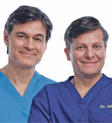Unfortunately, all body building programs are not created equally when speaking in terms of muscle fiber types. While you cannot differentiate between muscle fibers from your outside appearance, on the inside of the muscle tissue body, there are three different fibers present.
- Type 1 - Slow twitch for endurance
- Type 2A - Fast twitch for quick explosiveness
- Type 2B - Fast twitch for short duration quickness
Slow Twitch Muscle Fiber
Slow twitch muscle fiber would be used if you were to run a marathon or any other extended duration, medium to low intensity activity. These muscle fibers have a very high ability to resist fatigue and have a large oxidative (oxygen caring) capacity. Typically, these muscles can be used for hours without experiencing high levels of fatigue. They are relatively slow to contract and do not generate a great deal of force, and thus, are not used in exercises requiring a high degree of power.
The major fuel source for slow twitch muscles is triacylglyceride that comes from vegetable oil and animal fat. Foods that raise your triacylglyceride levels are: fresh vegetables, eggs, and low fat plain or fruit yogurt. Slow twitch muscles are very high in terms of mitochondrial density and have a large number of capillaries running throughout their bodies. This is to enable sufficient oxygen to get to the muscle tissues so that they can carry on the extended duration of muscular work.
To improve slow twitch muscle fibers, think endurance. This type of fiber will usually require the greatest amount of time to train for improvement because you will want to focus on simply going longer. If you are a runner, try to run longer. If you are a biker, bike longer. If you are a swimmer, swim longer.
Fast Twitch Type 2A Muscle Fiber
The next muscle group is type 2A fast twitch muscle fiber that is responsible for the most forceful muscle contractions but will fatigue quickly. They tend to have very large motor neurons and very low mitochrondrial density (oxygen carrying capacity). They also have a low oxidative capacity, meaning they will not be able to utilize oxygen very well. It is for this reason that they are not suited to endurance type of activities, because during these exercise variations, oxygen must be present in order to sustain the muscular contractions.
The major fuel sources for type A muscles are creatine phosphate and stored muscle glycogen (glucose). They will not utilize stored body fat at all due to the fact that they are only able to continually contract for a few seconds. Foods that enhance type A muscle activity are: high in protein (lean beef, skinless chicken, and fish) and natural carbohydrates (rice, potato, pasta, cereal, and nuts).
Since type A are your primary force generators, if you wish to get a higher performance from them you will need to train using exercises that require you to max out your effort for a short period of time. For example, sprint 50 meters at full speed, power lift for 1 to 5 repetitions per set, and any type of plyometric activities.
Fast Twitch Type 2B Muscle Fiber
The last muscle group is type 2B fast twitch muscle fiber that is responsible for short duration (typically measured in minutes) energy bursts, but not at an all out pace. An example of when this muscle group is used are if you were doing a running interval at about 80 to 90% of your maximum capacity for a couple of minutes.
Some of the characteristics of the type B muscle fiber are that they still have a large motor neuron (not as large as type A though). They are on the intermediate scale of fatigue resistance and they have a high degree of mitochondrial density. These muscle fiber types are able to use oxygen to a great extent as demonstrated by their higher resistance to fatigue and longer duration of contraction abilities.
The major fuel source for type B muscles is the same as for type A fast twitch muscles: natural high protein and high carbohydrate foods.
To train your type B muscle fibers you will want to slightly decrease the force with which you are to contract while simultaneously increasing the time over which you contract ever so slightly. For example, perform 30 to 45 intervals repeated ten times with 60 to 90 seconds of low to moderate pace activity in between. For your weight training activities, aim to target the 6 to 10 repetition range to utilize the fact that these muscles have a higher oxidation ability.
Summary
All three types of muscle fiber are used and need to be developed to maximize your muscle building activities. A well designed training routine can incorporate the development of slow twitch and fast twitch muscle fibers each workout.

